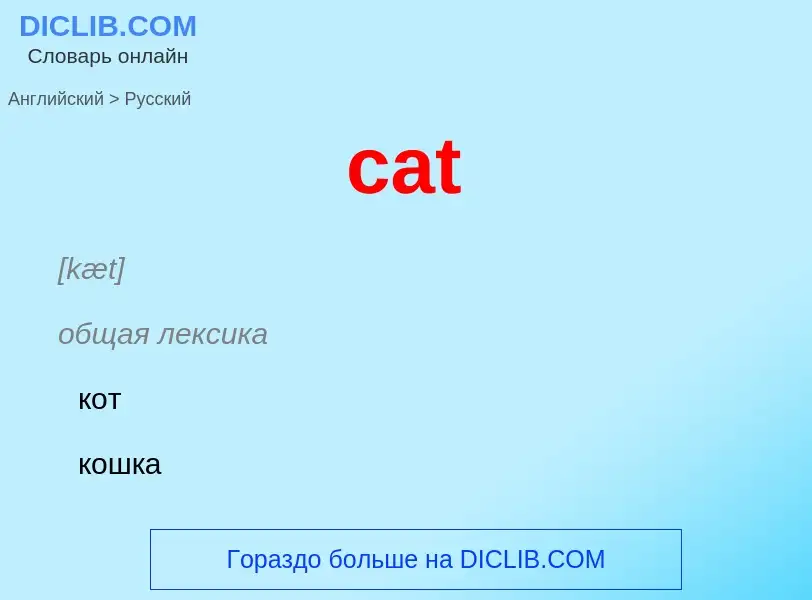Перевод и анализ слов искусственным интеллектом ChatGPT
На этой странице Вы можете получить подробный анализ слова или словосочетания, произведенный с помощью лучшей на сегодняшний день технологии искусственного интеллекта:
- как употребляется слово
- частота употребления
- используется оно чаще в устной или письменной речи
- варианты перевода слова
- примеры употребления (несколько фраз с переводом)
- этимология
CAT - перевод на Английский
[kæt]
общая лексика
кот
кошка
домашняя кошка (Felis domesticus)
твердая огнеупорная глина
каталитический
нефтегазовая промышленность
гусеничный трактор-вездеход (для подготовки площадки для буровой установки)
узел из загнутых нитей троса (для заправки в канатный замок)
перемещать тяжёлое оборудование с помощью лебёдки бурового станка
существительное
[kæt]
общая лексика
кот
кошка
двойной треножник
зоология
кошка домашняя (Felis domesticus)
животное семейства кошачьих
разговорное выражение
сварливая или недоброжелательная женщина
сплетница
язва
гусеничная машина
гусеничный трактор
сленг
парень
проститутка
джазист
«лабух»
поклонник джаза
странствующий рабочий
франт
стиляга
продавец наркотиков
спорт
чижик (заострённая палочка)
игра в чижики
морской термин
кат
собирательное выражение
сварливая женщина
сокращение
of caterpillar tractor
синоним
глагол
общая лексика
бить кошкой
плетью-девятихвосткой
бить плетью
сленг
блевать
морской термин
брать якорь на кат
жаргонизм
изрыгать
[kæt]
общая лексика
(Computer-Aided Testing) автоматизированное тестирование, автоматизация тестирования
(Computer-Aided Tomography) компьютерная томография
метод, оборудование и ПО построения трехмерного изображения органов или предметов
(Computer-Assisted Training [Teaching]) компьютеризированное [автоматизированное] обучение
(Cognitive Abilities Test) тест на уровень познавательных способностей
сокращение
от college of advanced technology
медицина
томоденситография
Смотрите также
существительное
общая лексика
компьютерная томография
синоним
математика
категория категорий
математика
тривиальная категория
[kætə'nainteilz]
существительное
общая лексика
кошка-девятихвостка (плеть из девяти ремней)
американизм
cat's tail
общая лексика
кошка Жоффруа (Felis geoffroyi)
Определение
Википедия

The cat (Felis catus) is a domestic species of small carnivorous mammal. It is the only domesticated species in the family Felidae and is commonly referred to as the domestic cat or house cat to distinguish it from the wild members of the family. Cats are commonly kept as house pets but can also be farm cats or feral cats; the feral cat ranges freely and avoids human contact. Domestic cats are valued by humans for companionship and their ability to kill rodents. About 60 cat breeds are recognized by various cat registries.
The cat is similar in anatomy to the other felid species: it has a strong flexible body, quick reflexes, sharp teeth, and retractable claws adapted to killing small prey like mice and rats. Its night vision and sense of smell are well developed. Cat communication includes vocalizations like meowing, purring, trilling, hissing, growling, and grunting as well as cat-specific body language. Although the cat is a social species, it is a solitary hunter. As a predator, it is crepuscular, i.e. most active at dawn and dusk. It can hear sounds too faint or too high in frequency for human ears, such as those made by mice and other small mammals. It also secretes and perceives pheromones.
Female domestic cats can have kittens from spring to late autumn, with litter sizes often ranging from two to five kittens. Domestic cats are bred and shown at events as registered pedigreed cats, a hobby known as cat fancy. Population control of cats may be achieved by spaying and neutering, but their proliferation and the abandonment of pets has resulted in large numbers of feral cats worldwide, contributing to the extinction of entire bird, mammal, and reptile species.
It was long thought that cat domestication began in ancient Egypt, where cats were venerated from around 3100 BC, but recent advances in archaeology and genetics have shown that their domestication occurred in Western Asia around 7500 BC.
As of 2021, there were an estimated 220 million owned and 480 million stray cats in the world. As of 2017, the domestic cat was the second most popular pet in the United States, with 95.6 million cats owned and around 42 million households owning at least one cat. In the United Kingdom, 26% of adults have a cat, with an estimated population of 10.9 million pet cats as of 2020.


.jpg?width=200)

![papillae]] on a cat's tongue act like a [[hairbrush]] to help clean and detangle fur papillae]] on a cat's tongue act like a [[hairbrush]] to help clean and detangle fur](https://commons.wikimedia.org/wiki/Special:FilePath/Cat tongue macro.jpg?width=200)

![When cats mate, the tomcat (male) bites the scruff of the female's neck as she assumes a position conducive to [[mating]] known as [[lordosis behavior]]. When cats mate, the tomcat (male) bites the scruff of the female's neck as she assumes a position conducive to [[mating]] known as [[lordosis behavior]].](https://commons.wikimedia.org/wiki/Special:FilePath/Cats having sex in Israel.jpg?width=200)

![Feral [[farm cat]] Feral [[farm cat]]](https://commons.wikimedia.org/wiki/Special:FilePath/Feral cat Virginia crop.jpg?width=200)


![A domestic cat with its prey, a [[deermouse]] A domestic cat with its prey, a [[deermouse]]](https://commons.wikimedia.org/wiki/Special:FilePath/Kot z myszą.jpg?width=200)



![A cat eating a fish under a chair, a [[mural]] in an Egyptian tomb dating to the 15th century BC A cat eating a fish under a chair, a [[mural]] in an Egyptian tomb dating to the 15th century BC](https://commons.wikimedia.org/wiki/Special:FilePath/Tomb of Nakht (7).jpg?width=200)





